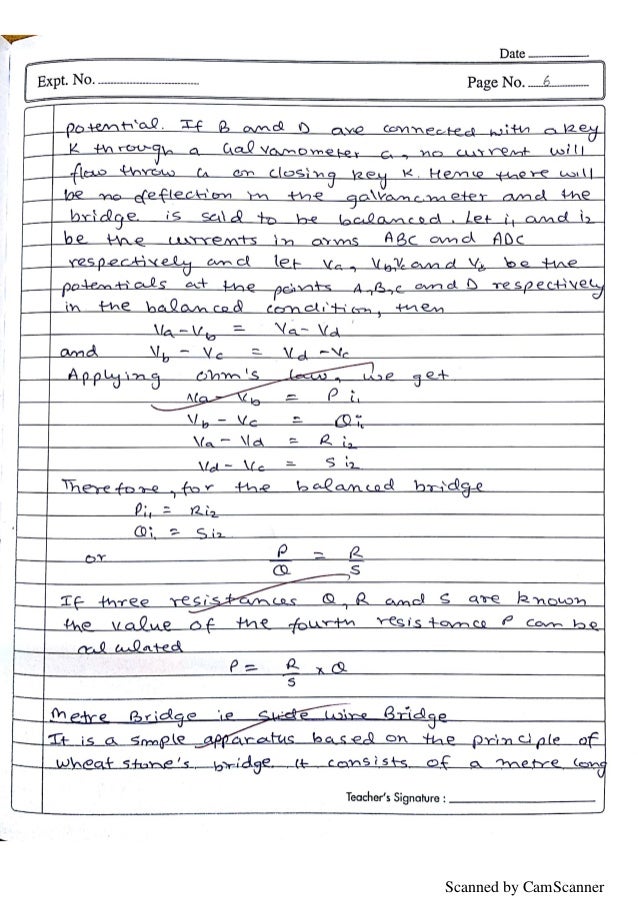
Physics Practical File - with Readings Class 12 CBSE • 1.
EXP-1> TO DETERMINE THE RESISTANCE PER CM OF A GIVEN WIRE BY PLOTTING A GRAPH OF POTENTIAL DIFFERENCE VERSUS CURRENT Materials Required: A Resistance wire, voltmeter, ammeter, battery, rheostat, meter scale, one way key, connecting wires etc. Theory: If I be the current flowing through a conductor & V be the potential difference across its ends, then according to Ohm’s law V∝I or V = RI Where, R is the constant of proportionality. It is known as resistance of the conductor. V/I=R R depends upon the nature of material, temperature & dimensions of the conductor.
Procedure: 1. Clean the ends of the connecting wires with the help of sand paper in order to remove any insulating coating on them. Connect various components - resistance, rheostat, battery, key, voltmeter and ammeter 3.
Jul 05, 2017 Physics Practical (Class 12) The document uploaded consists of the complete & checked Physics practical file that is required at the time of submission in Final Board Practical of Class 12. The file is complete & consists of the full data that is required in. Physics Practical class 12th cbse board:click → Physics practicals Hello! Friends, got no time or no friends to borrow chemistry practical file reading and you need it badly right now: here is.
Note whether pointers in milli-ammeter and voltmeter coincide with the zero mark on the measuring scale. If it is not so, adjust the pointer to coincide with the zero mark by adjusting the screw provided near the base of the needle using a screw driver. Note the range and least count of the given voltmeter and milliammeter. Insert the key K and slide the rheostat contact to one of its extreme ends, so that current passing through the resistance wire is minimum. Note the milli-ammeter and voltmeter readings.
Remove the key K and allow the wire to cool, if heated.  Again insert the key. Shift the rheostat contact slightly to increase the applied voltage. Note the milli-ammeter and voltmeter reading. Repeat step 7 for four different settings of the rheostat. Record your observations in a tabular form.
Again insert the key. Shift the rheostat contact slightly to increase the applied voltage. Note the milli-ammeter and voltmeter reading. Repeat step 7 for four different settings of the rheostat. Record your observations in a tabular form.
OBSERVATIONS: 1. Range of ammeter = 0. Least count of ammeter =.
Range of voltmeter = 0. Least count of voltmeter =.V 5. Least count of meter scale =. Tom clancys the division crack.
Length of the given wire, l =.m RESULT: 1. The potential difference across the given wire varies linearly with the current. The resistance per unit length of the wire is (R ± ΔR) = (.
----------------------------------------------------------------------------------- EXP-2> TO DETERMINE RESISTANCE OF GALVANOMETER BY HALF DEFLECTION METHOD AND TO FIND ITS FIGURE OF MERIT. MATERIAL REQUIRED: A moving coil galvanometer, a battery or a battery eliminator (0 - 6 V), one resistance box (R-BOX 1) of range 0-10kΩ, one resistance box(R-BOX 2) of range 0-200 Ω, 2 one way keys, voltmeter, connecting wires and a piece of sand paper. Theory: Galvanometer is a sensitive device used to detect very low current. Its working is based on the principle that a coil placed in a uniform magnetic field experiences a torque when an electric current is set up in it. The deflection of the coil is determined by a pointer attached to it, moving on the scale. When a coil carrying current I is placed in a radial magnetic field, the coil experiences a deflection θ which is related to I as I=k θ where k is a constant of proportionality and is termed as figure of merit of the galvanometer.
Procedure: 1. Clean the connecting wires with sand paper and make neat and tight connections as per the circuit diagram 2. From the high resistance box (R-BOX 1) (1-10 kΩ), remove 5 kΩ key and then close the key K1. Adjust the resistance R from this resistance box to get full scale deflection on the galvanometer dial. Record the values of resistance, R and deflection θ.
New Pages
- Vibrostol Chertezhi
- Bosch Ecu Tuning Software Download
- Ice Cube The Predator Rar
- Musiclab Realeight V1007183 Incl Crack And Keygen R2r
- Seahawks Tv Serial Episodes
- Llama Firearms Serial Numbers
- Microsoft Train Simulator No Cd Crack Download
- Testi Psihologicheskie Pri Postuplenii V Mvd Cpd 566 Voprosov
- O Sajna Table No 21 Lyrics Mp3 Song Free Download
- Bow Wow Wow Discography Download Torrent2342355
- Young Jeezy Beez Like Download Audiomack
- Datawedge Download Mc9190z
- Akon Journey Mp3 Song Free Download